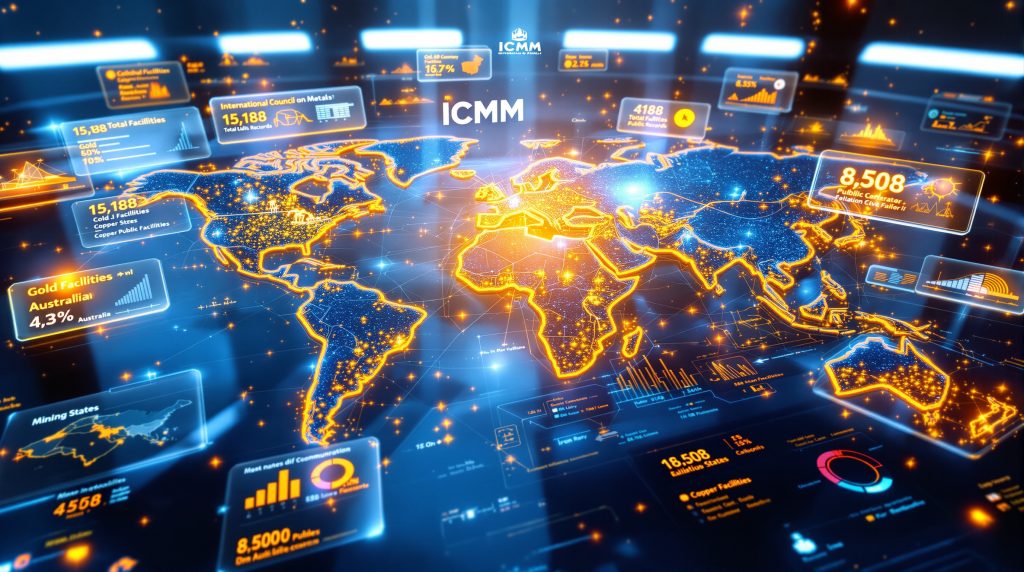The International Council on Mining and Metals has revolutionised global mining transparency through its groundbreaking ICMM worldwide global mining database, launched publicly on September 3, 2025. This comprehensive initiative represents the first systematic attempt to catalogue mining operations at a truly global scale, addressing long-standing information gaps that have hindered effective decision-making across the global mining landscape.
The database encompasses 8,508 operational mine and processing facilities available for public access, drawn from a broader research compilation of 15,188 total facilities worldwide. Furthermore, the initiative covers 47 different mineral commodities across all major operation categories, including mines, smelters, refineries, and processing plants. Each facility record includes precise geographic coordinates in WGS 84 format, primary and secondary commodity classifications, and confidence ratings that signal data verification levels.
Defining the ICMM's Revolutionary Data Initiative
The scale of this undertaking becomes apparent when examining its scope: nearly 6,680 facilities remain restricted from public release due to proprietary data sourcing agreements with S&P Capital IQ Pro. This limitation highlights the complex challenge of balancing transparency with commercial data protection, while still delivering unprecedented access to mining facility information.
Emma Gagen, Director of Data and Research at ICMM, emphasised the project's foundational importance: "the database addresses acknowledged information gaps where decisions were previously made based on incomplete information or limited case studies rather than comprehensive data analysis." This represents a significant shift in how the industry approaches data driven mining operations.
The collaborative development process involved partnerships with professional services company Accenture, data analysis firm Global Energy Monitor, and sustainable mining consultant firm Skarn Associates. Consequently, this multi-partner approach enabled integration of public governmental registers, proprietary commercial databases, academic research, and industry reports into a unified, standardised format.
Key Components and Data Architecture
| Component | Details | Coverage |
|---|---|---|
| Facility Types | Mines, smelters, refineries, processing plants | All major operation categories |
| Geographic Data | Latitude/longitude coordinates (WGS 84 format) | Global positioning accuracy |
| Commodity Classification | Primary and secondary mineral products | 47 commodity types |
| Confidence Ratings | Data verification levels | Quality assurance metrics |
The database architecture incorporates sophisticated quality control measures to address information inconsistencies. When multiple data sources provided conflicting facility names, coordinates, or commodity classifications, ICMM retained all variations in separate data columns rather than arbitrarily selecting one version. In addition, this approach maintains data integrity while transparently signalling areas requiring further verification.
How Does the ICMM Database Address Critical Industry Data Gaps?
Prior to this database release, no comprehensive public resource covered over 15,000 mining facilities at global scale. The project identified systematic information deficiencies that forced industry stakeholders, policymakers, and researchers to base critical decisions on assumptions rather than verified data.
The Problem of Information Scarcity in Mining
Regional transparency variations represent the primary obstacle to comprehensive data compilation. Gagen identified this "regional opacity" as spanning a spectrum from abundant, publicly available information in some jurisdictions to virtually no accessible data in others. For instance, areas appearing blank on the database's world map visualisation do not necessarily indicate absence of mining activity, but rather regions where information access has not yet been achieved due to limited corporate reporting systems or regulatory disclosure requirements.
The immediate response to the database launch validates the industry's data hunger. However, Gagen reported receiving a flood of collaboration requests since September 3, 2025, with organisations offering to help improve country-specific data, add visualisation tools, or contribute environmental geospatial layers.
Collaborative Development Process and Methodology
The verification process relied primarily on desktop-based validation due to logistical constraints of manually assessing 15,188 facilities globally. ICMM explicitly acknowledged this limitation, calling for partner organisations to help improve confidence levels in sites where initial verification was incomplete.
Each facility record includes confidence level assignments that indicate data certainty levels. This transparent approach signals to end-users which records have been validated versus those requiring further verification, maintaining scientific integrity while acknowledging the ongoing nature of data refinement.
Dr. Donna Beneteau from the University of Saskatchewan, who developed the Historical Canadian Mines Data Hub in collaboration with CIM in 2021, emphasised the institutional challenges underlying data gaps. Furthermore, mining companies frequently change ownership through mergers and acquisitions, are often privately held without public disclosure requirements, or lack standardised reporting infrastructure.
What Geographic Patterns Emerge from Global Mining Distribution?
The ICMM worldwide global mining database reveals striking geographic concentration patterns that have significant implications for supply chain resilience and industry development strategies. Nearly 45% of all documented mining facilities are concentrated in just three countries: China, Australia, and the United States, representing approximately 6,834 facilities out of the total 15,188 documented operations.
Regional Concentration Analysis
"Nearly 45% of all documented mining facilities are concentrated in just three countries: China, Australia, and the United States, revealing significant geographic clustering in global mining operations."
This concentration pattern extends beyond individual countries to continental clustering, with Asia demonstrating particular dominance in global mining infrastructure. Consequently, the geographic distribution reveals both established mining regions with developed infrastructure and emerging opportunities in areas where data accessibility remains limited.
Asia's Dominance in Mining Infrastructure
Gagen's analysis identified Asia as the most significant strategic priority zone for industry improvement efforts. "Asia as a regional cluster far outweighs any other part of the world in terms of facility numbers, creating both the greatest challenge in terms of operation volume and the greatest leverage point for raising industry standards."
When examining India and China's facilities combined, Asia's specialisation in coal, gold, copper, and iron ore production becomes even more pronounced than the three-country concentration metric alone suggests. This indicates continental rather than merely national clustering patterns in global mining operations, which has implications for the broader mining industry evolution.
| Region | Estimated Facility Count | Percentage of Total | Primary Commodities |
|---|---|---|---|
| Asia | 7,500+ | 50%+ | Coal, gold, copper, iron ore |
| North America | 3,000+ | 20%+ | Coal, gold, copper |
| Australia/Oceania | 2,200+ | 15%+ | Iron ore, coal, gold |
The implications for supply chain resilience are substantial. Gagen noted that if standards can be raised across Asia's mining facilities, the global impact is maximised due to the sheer volume of operations and number of communities impacted by facilities in the region.
Which Commodities Dominate the Global Mining Landscape?
The ICMM worldwide global mining database reveals that approximately 80% of the 15,188 facilities produce one of four commodities: coal, gold, copper, or iron ore. This represents roughly 12,150 facilities focused on these traditional mining commodities, with coal operations alone accounting for 43% of total mining operations globally, equating to approximately 6,530 coal-related facilities.
The Big Four: Coal, Gold, Copper, and Iron Ore
This commodities concentration pattern reflects both historical mining development and current market demands. Coal mining's 43% share of global facilities underscores the continued importance of fossil fuel extraction in the global mining landscape, despite increasing emphasis on energy transition minerals.
The geographic correlation between Asia's facility dominance and the Big Four commodities is particularly striking. Asia's specialisation in coal, gold, copper, and iron ore production aligns with the region's concentration of mining infrastructure, indicating established supply chains and processing capabilities for these traditional commodities.
Commodity Diversification Opportunities
The remaining 20% of facilities working with alternative commodities represents approximately 3,038 facilities across 43 other mineral types, including critical minerals essential for energy transition technologies. This disparity highlights the mining industry's historical commodity focus versus emerging critical minerals energy security needs for lithium, cobalt, rare earth elements, nickel, and molybdenum.
Gagen noted that while the Big Four dominance pattern may not surprise industry experts, having definitive quantification enables evidence-based policy discussions, investment decisions, and strategic planning rather than assumption-based approaches. Furthermore, the database provides crucial validation that 80% of global mining facilities concentrate on four commodities, while strategic minerals for renewable energy and technology applications remain underrepresented in global mining infrastructure.
Strategic minerals underrepresentation suggests significant opportunities for industry diversification, particularly as global demand shifts toward materials essential for renewable energy systems, electric vehicles, and advanced technologies. However, this data-driven insight enables policymakers and investors to identify specific gaps between current mining infrastructure and future commodity requirements.
How Can Organisations Access and Utilise This Mining Database?
The ICMM worldwide global mining database operates on a dual-access model designed to balance transparency with proprietary data protection. The 8,508 publicly available facility records can be accessed without cost through ICMM's official database portal, while 6,680 restricted facilities remain unavailable due to licensing agreements with commercial data provider S&P Capital IQ Pro.
Public Access Framework and Licensing Considerations
Free access provisions cover comprehensive facility information including geographic coordinates in WGS 84 format, primary and secondary commodity classifications, facility names, and confidence level ratings. The database excludes artisanal and small-scale operations, exploration sites, feasibility studies, quarries, and historical or legacy facilities due to missing information or methodological scope limitations.
Download procedures require standard registration through ICMM's portal, with data available in multiple formats compatible with geographic information systems and standard data analysis software. Terms of use emphasise attribution requirements for research applications while permitting both academic and commercial utilisation of the publicly available dataset.
Practical Applications Across Industries
The ICMM worldwide global mining database serves multiple stakeholder groups including policy makers developing mining regulations, investors conducting due diligence on mining projects, researchers analysing supply chain patterns, and environmental organisations assessing mining impacts on protected areas.
Beneteau emphasised the database's value for public engagement, noting that free accessibility helps people outside the mining industry become informed about sector operations. When the Historical Canadian Mines Data Hub launched, researchers from fields including air quality, wildlife management, and food security utilised mining facility data for interdisciplinary research applications.
Policy development applications include regulatory planning, environmental impact assessment frameworks, and international trade analysis. Investment research and due diligence processes benefit from standardised facility data enabling comparative analysis across regions and commodity types.
Academic research applications span supply chain analysis, economic geography studies, environmental impact assessments, and community development research. Furthermore, environmental organisations can overlay facility locations with protected area boundaries, water stress indicators, and biodiversity conservation priorities.
What Are the Database's Current Limitations and Future Expansion Plans?
The ICMM worldwide global mining database acknowledges significant limitations inherent in desktop-based verification methodologies and regional data accessibility challenges. Manual verification of all 15,188 facilities would require on-the-ground assessment, which remains operationally prohibitive for a project of this scope.
Data Quality Challenges and Confidence Ratings
Regional transparency variations create systematic data gaps where mining activity occurs but information access has not been achieved. These "opacity" issues affect areas with weak regulatory frameworks, restricted political systems, or developing nations with limited corporate reporting infrastructure.
Facility naming inconsistencies and coordinate accuracy challenges emerge when multiple data sources provide contradictory information. ICMM's response involved preserving all conflicting information in separate data columns while assigning confidence level ratings to signal verification certainty rather than arbitrarily selecting one version.
The exclusion of artisanal and small-scale mining operations represents a substantial gap, particularly in regions where informal sector mining provides significant economic activity and mineral production. These operations often lack formal registration or standardised reporting, making systematic documentation extremely challenging.
Five-Year Development Roadmap
ICMM's strategic expansion plans include environmental and social governance indicator integration within the next several years. Planned overlays include protected area boundaries, water stress indicators, and drought risk assessments that can be combined with facility locations to identify potential conflict areas or operational risks.
Community and economic impact data incorporation represents a longer-term objective, requiring collaboration with local governments, academic institutions, and community organisations to develop standardised metrics for facility-level socioeconomic effects. This development would align with broader industry initiatives showcased at events like the global mining innovation expo.
Gagen's long-term vision involves transforming the project into an independent agency focused on freely distributing reliable mining information accessible to public users. This transition would address potential concerns about industry body credibility while maintaining the database's transparency and accessibility principles.
Environmental layer integration plans include water stress mapping, biodiversity conservation priority areas, and climate vulnerability indicators. These additions would enable comprehensive facility-level risk assessment for environmental and operational planning purposes.
How Does This Database Compare to Existing Mining Information Resources?
The ICMM worldwide global mining database distinguishes itself from existing mining information resources through its combination of global scope, free accessibility, and standardised data format. While other mining databases exist, they typically suffer from geographical limitations, paywall restrictions, or inconsistent data structures that limit comparative analysis capabilities.
Competitive Landscape Analysis
| Database Type | Accessibility | Scope | Cost Structure |
|---|---|---|---|
| ICMM Global Dataset | Public/Free | 8,508+ facilities | No cost |
| Commercial Databases | Subscription | Variable | Paywall restricted |
| Regional Databases | Mixed | Country-specific | Variable |
| Company Reports | Limited | Single operations | Often restricted |
Commercial databases often provide more detailed facility-level information but restrict access through subscription fees that can exclude academic researchers, non-profit organisations, and public sector users. Regional databases typically offer superior local detail but lack standardisation for cross-border comparative analysis.
Unique Value Propositions
The database's comprehensive global coverage enables analysis at continental and international scales previously impossible with country-specific or regional datasets. Furthermore, standardised data format facilitates cross-regional comparisons and supply chain mapping across national boundaries.
Free accessibility democratises mining data access, enabling public engagement and research by organisations without substantial database licensing budgets. Beneteau specifically noted that paywall restrictions prevent public engagement with mining sector information, emphasising the educational value of freely accessible data.
Community-driven improvement mechanisms allow users to contribute corrections, additions, and verification support, creating a collaborative approach to data quality enhancement. This differs from commercial databases that rely solely on internal verification processes.
The confidence rating system provides transparent quality assessment, enabling users to evaluate data reliability rather than assuming uniform accuracy across all records. Consequently, this methodological transparency supports scientific rigour in research applications.
What Impact Will This Database Have on Mining Industry Transparency?
The ICMM worldwide global mining database represents a fundamental shift toward industry transparency that enables informed public discourse, evidence-based policy development, and enhanced stakeholder engagement across mining operations worldwide. The project's impact extends beyond data provision to include educational initiatives and collaborative improvement processes.
Advancing Public Understanding of Mining Operations
Free accessibility breaks down traditional information barriers between industry operations and community awareness. The database enables citizens, researchers, and organisations to access comprehensive mining facility information without commercial licensing restrictions or proprietary access requirements.
Beneteau emphasised the educational imperative: "mining industry professionals must find new ways of engaging with those unfamiliar with the sector, and transparent data sharing represents a crucial component of this outreach." She noted that failure to share information prevents public learning and represents an industry shortcoming.
The database facilitates informed public discourse on mining policies by providing factual foundations for discussions about facility locations, commodity production patterns, and regional economic impacts. This evidence-based approach can improve the quality of community consultations and environmental impact assessments.
Driving Industry Standards and Best Practices
Benchmarking opportunities emerge when facilities can be compared across regions, commodity types, and operational scales using standardised data formats. This comparative analysis capability supports identification of best practices and areas requiring improvement across global mining operations.
The geographic concentration analysis revealing Asia's facility dominance creates specific opportunities for targeted industry improvement initiatives. Gagen noted that Asia represents the biggest opportunity for raising standards across mining operations due to the sheer volume of facilities and communities impacted.
Supply chain traceability benefits from comprehensive facility mapping that enables tracking of mineral production from extraction through processing and refining stages. Furthermore, this transparency supports responsible sourcing initiatives and due diligence processes for downstream users.
Enhanced stakeholder engagement becomes possible when communities, investors, and policymakers can access reliable information about mining operations in their regions. This information foundation supports more productive consultations and collaborative planning processes.
Frequently Asked Questions About the ICMM Mining Database
Technical and Access Questions
How often is the database updated? The ICMM worldwide global mining database follows an ongoing improvement model rather than fixed update schedules. Gagen emphasised that data refinement occurs continuously as partner organisations contribute corrections, additions, and verification support. Consequently, the collaborative approach means updates happen when new information becomes available rather than on predetermined timelines.
What file formats are available for download? The database provides data in formats compatible with geographic information systems and standard data analysis software. Technical specifications include latitude and longitude coordinates in WGS 84 standard format, enabling direct integration with mapping and spatial analysis tools.
Can users contribute corrections or additions? Community participation represents a core component of the database improvement strategy. Since the September 3, 2025 launch, ICMM has received numerous collaboration offers from organisations seeking to improve country-specific data, add commodity-specific information, or contribute verification support for low-confidence facility records.
Usage and Application Questions
Is commercial use permitted? The publicly available dataset supports both academic and commercial applications under standard attribution requirements. The 8,508 publicly accessible facility records can be utilised for investment research, policy development, academic studies, and commercial analysis without licensing fees.
How accurate are the geographic coordinates? Coordinate precision varies based on source data quality and verification methodology. The confidence rating system transparently indicates data reliability levels, enabling users to assess coordinate accuracy for specific facilities rather than assuming uniform precision across all records.
Are historical mining sites included? The database scope excludes historical and legacy mining sites, focusing instead on operational facilities. This methodology decision reflects the project's emphasis on current mining activity rather than comprehensive historical documentation, though expansion to include historical data may occur in future development phases.
Readers interested in learning more about global mining data initiatives can explore related educational content from industry publications and research organisations that focus on mining transparency and data standardisation efforts.
Disclaimer: The information presented in this article is based on publicly available sources and industry reports as of November 2025. Mining facility data, commodity classifications, and geographic distributions may change due to operational modifications, market conditions, or data refinement processes. Readers should verify current information through official ICMM channels and consult additional sources for investment or policy decisions.
Looking to Capitalise on Mining Discoveries Before the Market Reacts?
Discovery Alert's proprietary Discovery IQ model delivers instant notifications when significant ASX mineral discoveries are announced, transforming complex geological data into actionable trading opportunities. See how major discoveries like those documented in the ICMM database have historically generated substantial returns by visiting Discovery Alert's discoveries page, then begin your 30-day free trial to position yourself ahead of the market.




